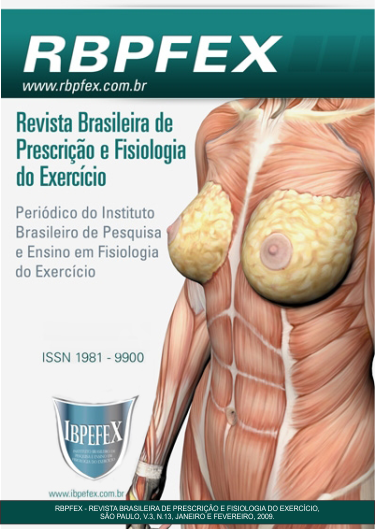Behavior of the muscular force through methods of distinct heatings for the test of 1RM
Abstract
The objective of the present study was to verify of that it forms the different methods of warm up could influence in the test of 1 maximum repetition (1RM) in the bench press exercise (BP). The sample was constituted of 12 individuals of the masculine sex, trained it has at least 12 months and all had been submitted to the different methods of warm up. The collection consisted of 8 days not-consecutive for the application of the tests, with interval of 48h it enters the days for accomplishment of the test and retest. The individuals had been submitted to the test of 1RM with the previous application of the specific warm up – Warm. spec (2 series of 15 repetitions with 50% of the corporal weight) for the agonist muscle; warm up of the antagonistic muscle – Warm. Antag (2 series of 15 repetitions with 50% of the corporal weight) in the seated rowed exercise of with the hands in pronation; stretching – Stret (2 series of 15 seconds) of the muscular groups that had acted in the movement and with absence of previous warm ups (control). The beginning of the exercise in both was used two minutes of interval preceding the warm ups. We conclude that difference does not exist statistics for analysis of the level of significance of 5% (a=0,05), for software Graph Pad Prism 5, in the test of 1RM in the bench press exercise through the different protocols of warm up, however warm up of the antagonistic muscle was observed a bigger load mobilization after.
References
- Abadie, B.R.; Wentworth, M.C. Prediction of one repetition maximal strength from a 5-10 repetition sub maximal strength test in college-aged females. JEPonline. 4(2):1-6, 2000.
- American College of Sports Medicine. Diretrizes do ACSM para os testes de esforço e sua prescrição. Rio de Janeiro: Guanabara Koogan, 2003.
- Aoki, M.S.; Pontes, F.L.; Navarro, F.; Uchida, M.C.; Bacurau, F.P.B. Suplementação de carboidratos não reverte não reverte o efeito deletério do exercício de endurance sobre o subseqüente desempenho da força. Rev Brás Med Esporte. 9(5):282-287, 2003.
- Bandy, W.D.; Irion, J.M. The effect of time on static stretch on the flexibility of the hamstring muscles. Phys Ther. 74:845-52, 1994.
- Jaric, S.; Ropret, R.; Kukolj, M.; Ilié, D.C. Role of agonist and antagonist muscle strength in performance of rapid movements. Eur J Appl Physiol. 71(5): 464-468, 1995.
- Kemmler, W.K.; Lauber, D.; Engelke, K.; Weineck, J. Effects of single Vs. multiple set resistance training on maximum strength and body composition in trained post menopausa women. J Streng Cond Res. 18(4),689–694, 2004.
- Kokkonen, J.; Nelson, A.G.; Cornwell, C. Acute muscle stretching inhibits maximal strength performance. Res Q Exerc Sport. 69:411-5, 1998.
- Kubo, K.; Kanehisa, H.; Kawakami, Y.; Fukunaga, T. Influence of static stretching on viscoelastic properties of human tendon structures in vivo. J Appl Phys. 90:520-7, 2001.
- Leemans, D. La problematique de l’ échauffement. In: Revue de I’Education Physique. 32:11-9, 1992.
- Maior, A.S.; Alves, Jr. C.L.; Ferraz, F.M.; Menezes, M.; Carvalheira, S.; Simão, R. Efeito hipotensivo dos exercícios resistidos em diferentes intervalos de recuperação. Rev Socerj. 20(1):53-59, 2007.
- Maior, A.S.; Menuci, T.; Soares, V.; Souza, L.R.; Gribov, M.; Simão, R. Variação da sobrecarga de treinamento no comportamento da força muscular e da percepção subjetiva de dor em mulheres. Revista Medicina. 41(2):168-76, 2008.
- Maior, A.S.; Varallo, A.T.; Matoso, A.G.P.S.; Edmundo, D.A.; De Oliveira, M.M.; Minari, V.A. Resposta da força muscular em homens com a utilização de duas metodologias para o teste de 1RM. Rev bras cineantropometria desempenho humano. 9(2):177-82, 2007.
- Pollock, M.L.; Frankilin, B.A.; Balady, G.J.; Chaitman, B.L.; Fleg, J.L.; Fletcher, B.; e colaboradores. Resistance exercise inindividual with and without cardiovascular disease: benefits, rationale, safety, and prescription. Circulation. 101:828-833, 2000.
- Rhea, M.R.; Alvar, B.A.; Burkett, L.N.; Ball, S.D. A meta-analysisto determine the dose response for strength development. Med Sci Sports Exerc. 35(3):456-464, 2003.
- Shrier, I.; Gossal, K. Myths and truths of stretching. Phys Sports Med. 28:18-25, 2000.
- Shrier, I. Stretching before exercise does not reduce the risk of local muscle injury: a critical review of the clinical and basic science literature. Clin J Sport Med. 9:221-7, 1999.
- Simão, R.; Giacomini, M.B.; Dornelles, T.S.; Marramom, M.G.F.; Viveiros, L. Influência do aquecimento específico e da flexibilidade no teste de 1RM. Rev Bras de Fisio do Exerc. 2:134-40, 2003.
- Simão, R.; Senna, G.; Nassif, L.; Leitão, A.; Arruda, R.; Priore, M.; Maior, A.S.; Polito, M. Influência dos diferentes protocolos de aquecimento na capacidade de desenvolver carga máxima no teste de 1RM. Fitness Perf J. 3:261-5, 2004.
- Sweet, S. Warm-up or no warm-up. J Strength Condition Res. 23(6):36-45, 2001.
Authors who publish in this journal agree to the following terms:
- Authors retain the copyright and grant the journal the right of first publication, with work simultaneously licensed under the Creative Commons Attribution License BY-NC which allows the sharing of the work with acknowledgment of the authorship of the work and initial publication in this journal.
- Authors are authorized to enter into additional contracts separately for non-exclusive distribution of the version of the work published in this journal (eg, publishing in institutional repository or book chapter), with acknowledgment of authorship and initial publication in this journal.
- Authors are allowed and encouraged to post and distribute their work online (eg, in institutional repositories or on their personal page) at any point before or during the editorial process, as this can bring about productive change as well as increase impact and impact. citation of published work (See The Effect of Free Access).






